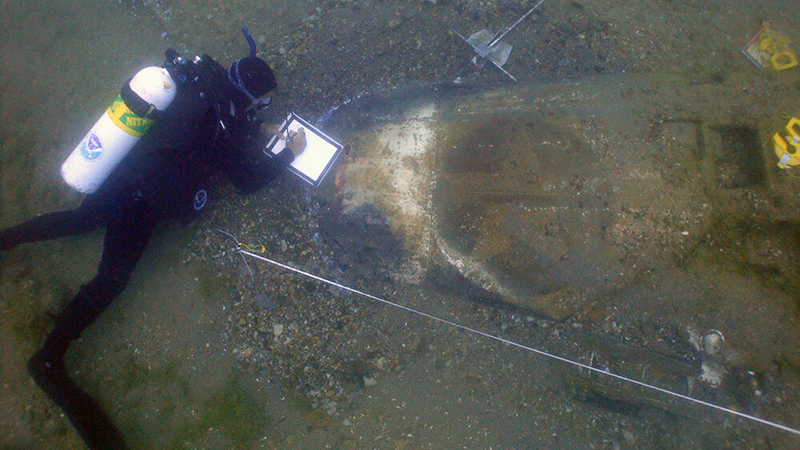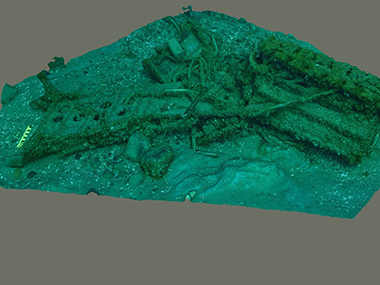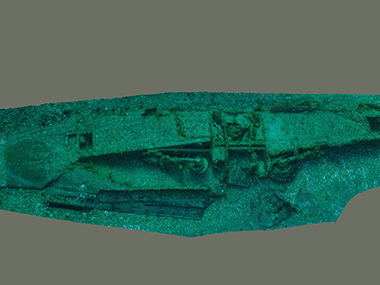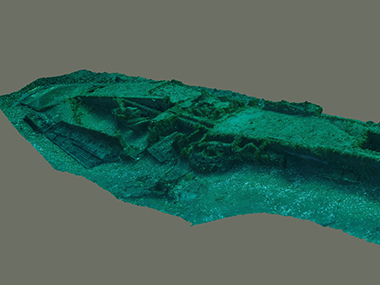Bell P-39Q Airacobra (#42-21226)
Background
The Bell P-39Q Airacobra was an American-built fighter that served in the U.S. Army Air Force during World War II. Bell Aircraft produced 4,905 of these aircraft between 1943 and 1944.
Overall, a P-39Q was 9.2 meters long and 10.4 meters wide. It was equipped with an Allison V-1710 V-12 engine, which was mounted directly behind the cockpit. Its armament included one 37 millimeter T9 cannon, two Browning M2 .50 caliber (12.7 millimeter) machine guns, and four Browning M1919 .30 caliber (7.62 millimeter) machine guns.
The Tuskegee airmen trained in Bell P-39Q Airacobras over the Great Lakes. During a gunnery training exercise on April 11, 1944, Second Lieutenant Frank Moody’s P-39Q Airacobra (#42-21226) crashed while operating approximately 50 to 100 feet above Lake Huron. Prior to the crash, it was reported that small pieces of debris were coming from the forward right side of the aircraft along with a trail of black smoke. Moody raised the nose of the aircraft before it hit the water. The aircraft then cartwheeled and sank into Lake Huron approximately four miles north of Port Huron, Michigan.

Exploration
In August 2015, Wayne Lusardi, an archaeologist with the Michigan Department of Natural Resources, led a team of divers from NOAA’s Thunder Bay National Marine Sanctuary and Diving With a Purpose to try to find Moody’s P-39Q. They found an intact wing and an Allison V-12 engine at a depth of approximately 10 meters.
In 2018 and 2019, NOAA Ocean Exploration supported Lusardi’s related Aviators Down project. The discovery of Moody’s aircraft and the Aviators Down project are part of a larger conversation and investigation into Tuskegee aviation training accidents across the Great Lakes. In August 2023, Michigan Department of Natural Resources conducted an excavation of the P-39Q wreck site in partnership with the Tuskegee Airmen National Museum.

Modeling
Prior to the excavation, NOAA Ocean Exploration maritime archaeologist Phil Hartmeyer conducted a series of scientific dives to photograph the wing and engine. Raymond Phipps, a NOAA Ocean Exploration explorer-in-training, then processed these photographs and made photogrammetric models.
These models are best viewed on a desktop computer.
Desktop:
- To zoom in and out: Use the scroll wheel on the mouse.
- To move around: Left click on the model with the mouse and drag.
- To rotate: Right click on the model with the mouse and drag.
Mobile Devices:
- To zoom in and out and rotate: Pinch
- To move around: Tap and drag any direction.
Photogrammetry model of the Allison V-12 engine of the Bell P-39Q Airacobra (#42-21226) developed by Raymond Phipps, NOAA Ocean Exploration explorer-in-training, August 4, 2023. Model courtesy of NOAA Ocean Exploration.
Photogrammetry model of the wing of the Bell P-39Q Airacobra (#42-21226) developed by Raymond Phipps, NOAA Ocean Exploration explorer-in-training, August 4, 2023. Model courtesy of NOAA Ocean Exploration.
Published October 17, 2024



